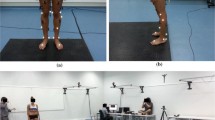Abstract
Several signal processing tools have been employed in the experimental study of the postural control system in humans. Among them, the cross-correlation function has been used to analyze the time relationship between signals such as the electromyogram and the horizontal projection of the center of gravity. The common finding is that the electromyogram precedes the biomechanical signal, a result that has been interpreted in different ways, for example, the existence of feedforward control or the preponderance of a velocity feedback. It is shown here, analytically and by simulation, that the cross-correlation function is depedent in a complicated way on system parameters and on noise spectra. Results similar to those found experimentally, e.g., electromyiogram preceding the biomechanical signal may be obtained in a postural control model without any feedforward control and without any velocity feedback. Therefore, correct interpretations of experimentally obtained cross-correlation functions may require additional information about the system. The results extend to other biomedical applications where two signals from a closed loop system are cross-correlated.
Similar content being viewed by others
References
Fitzpatrick R, Burke D, Gandevia SC (1996) Loop gain of reflexes controlling human standing measured with the use of postural and vestibular disturbances. J Neurophysiol 76:3994–4008
Gatev P, Thomas S, Kepple T, Hallett M (1999) Feedforward ankle strategy of balance during quiet stance in adults. J Physiol 514:915–928
Jeka J, Kiemel T, Creath R, Horak F, Peterka R (2004) Controlling human upright posture: velocity information is more accurate than position or acceleration. J Neurophysiol 92:2368–2379
Loram ID, Kelly SM, Lakie M (2001) Human balancing of an inverted pendulum: is sway size controlled by ankle impedance?. J Physiol 532:879–891
Loram ID, Maganaris CN, Lakie M (2005) Active, non-spring-like muscle movements in human postural sway: how might paradoxical changes in muscle length be produced?. J Physiol 564(1):281–293
Masani K, Popovic MR, Nakazawa K, Kouzaki M, Nozaki D (2003) Importance of body sway velocity information in controlling ankle extensor activities during quiet stance. J Neurophysiol 90:3774–3782
Maurer C, Peterka RJ (2005) A new interpretation of spontaneous sway measures based on a simple model of human postural control. J Neurophysiol 93:189–200
Morasso PG, Baratto L, Capra R, Spada G (1999) Internal models in the control of posture. Neural Netw 12:1173–1180
Peterka RJ (2000) Postural control model interpretation of stabilogram diffusion analysis. Biol Cybern 82:335–343
Peterka RJ (2002) Sensorimotor integration in human postural control. J Neurophysiol 88:1097–1118
Peterka RJ (2003) Simplifying the complexities of maintaining balance. IEEE Eng Med Biol Mag 22:63–68
van der Kooij H, van Asseldonk E, van der Helm FCT (2005) Comparison of different methods to identify and quantify balance control. J Neurosci Methods 145:175–203
Author information
Authors and Affiliations
Corresponding author
Rights and permissions
About this article
Cite this article
Kohn, A.F. Cross-correlation between EMG and center of gravity during quiet stance: theory and simulations. Biol Cybern 93, 382–388 (2005). https://doi.org/10.1007/s00422-005-0016-x
Received:
Accepted:
Published:
Issue Date:
DOI: https://doi.org/10.1007/s00422-005-0016-x




